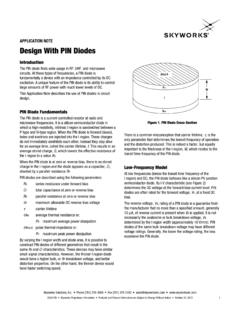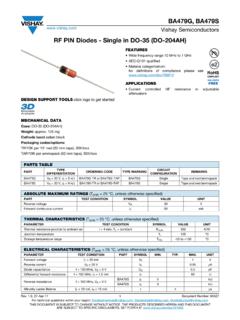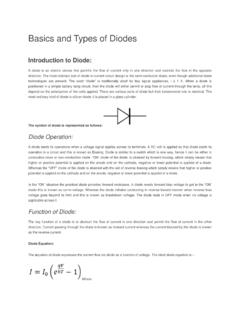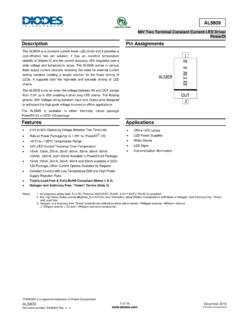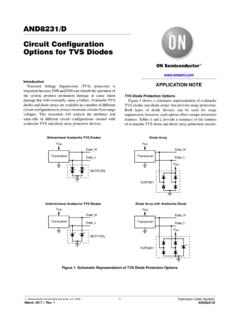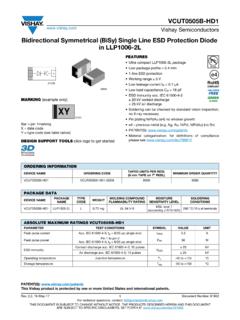Transcription of Design a transition-mode, bridgeless PFC with a …
1 Analog Applications Journal Industrial Design a transition-mode, bridgeless PFC with a standard PFC controller By Sheng-Yang Yu Application Engineer, Power Design Services Figure 1. Conventional two-stage power-supply system with high power-factor requirements Bridge Rectifier L1 D1. Isolated DC/DC. Converter EMI +. Cf S1 C1 Load Filter Introduction The aforementioned issues greatly increase the cost of a This article presents Design information for using a stan- bridgeless PFC circuit. An alternative bridgeless PFC with dard, low-cost, power factor correction (PFC) controller return diodes[4] is shown in Figure 2. to construct a high-efficiency transition-mode (TM) Slow-recovery return diodes, DR1 and DR2 in Figure 2, bridgeless -PFC power supply.
2 Driven by the Northwest alleviate EMI concerns. Moreover, the same pulse-width Energy Efficiency Alliance's 80 PLUS program,[1] com- modulation (PWM) signal can be used to drive both puter power-supply manufacturers are eager to investigate MOSFETs, which greatly reduces control complexity and ways to improve converter efficiency. A standard power- controller cost. supply system with high power-factor requirements is This article focuses on the Design considerations shown in Figure 1. of using low-cost standard analog-PFC controllers for The rectified input voltage is boosted to a level higher TM- bridgeless PFCs with return diodes.
3 Two 370-W refer- than the maximum input to ensure that a high power factor ence boards were built for performance evaluations with is achieved over the whole input range. After the boost the UCC28051 TM-PFC controller; a TM- bridgeless PFC. PFC, an isolated DC/DC converter steps the boost voltage and a TM-conventional PFC. The results show that over down through a safety isolated transformer. For a two- 97% efficiency can be achieved with the TM- bridgeless stage power supply with 400-W output power, power dissi- PFC prototype at 120 VAC, which is about 1% higher than pation of the bridge diodes could go up to 6 W with a full that of the TM-conventional PFC prototype.
4 Load and the input at 120 VAC/60 Hz. That is a effi- Digital controllers such as TI's C2000 real-time ciency reduction just because of the power dissipation by microcontrollers[5] are also widely used for controlling the bridge diodes. As a result, bridgeless PFCs[2] (a combi- bridgeless PFCs. nation of rectifier and boost converters). replace conventional PFCs for better con- Figure 2. bridgeless PFC with return diodes verter efficiency. However, the complexity of bridgeless -PFC control makes its control- ler more expensive than a standard analog- PFC controller. Additionally, the parasitic a D1 D2. capacitance on the bridgeless -PFC MOSFETs L1.
5 EMI. creates more electromagnetic interference VAC. Filter +. L2 C1 Load (EMI) than the conventional PFC. [3]. b DR1 DR2 S1 S2. texas instruments 14 AAJ 4Q 2014. Analog Applications Journal Industrial Circuit operations and Design considerations Circuit operations Figure 3. Operations of bridgeless PFC with return diodes The circuit operations of a TM- bridgeless PFC, shown in Figure 3, are similar to a boost converter. When VAC > 0 (or Va Vb > 0), the S1, S2 on: main currents flow through the first boost S1, S2 off: D1 D2. converter components, L1, S1, D1, C1 and L1. the load, then back to the source through a +. DR2.
6 When VAC < 0 (or Va Vb < 0), the main VAC > 0 L2 C1 Load currents flow through the second boost con- verter components, L2, S2, D2, C1 and the b DR1 DR2 S1 S2. load, then back to the source through DR1. The return diodes allow both switches S1. and S2 to be on and off at the same time to keep the boost converters operating normally. Design considerations D1 D2. A standard TM-PFC controller relies on the L1. sensing results of current-sensing and zero- a +. current-detection (ZCD) circuits as the on/ VAC > 0 L2 C1 Load off trigger of the driving signal. A current- sensing circuit is used to detect the peak b DR1 DR2 S1 S2.
7 Value of the inductor current to turn off the switch. A ZCD circuit detects the zero- . current point of the inductor current to turn on the switch. Another characteristic of a standard TM-PFC controller is that the switching-frequency range is much narrower than costly digital controllers. It is Figure 4. Current-sensing circuits important to properly Design the PFC inductors because they determine the switching frequency. There are three D1. key considerations when applying a standard TM-PFC To L 1. D2. controller to the TM- bridgeless PFC: Current-sensing cir- To L2 +. cuit Design , ZCD Design , and PFC-inductor Design .
8 C1. Current-sensing Design S1 S1 Load Power resistors for a peak current-sensing circuit (RCS1 CS. and RCS2 in Figure 4a) are no longer the first choice for bridgeless -PFC current sensing. This is mainly because RCS1 RCS2. there are two switch legs to be sensed. If each switch is in series with a current-sensing resistor, then additional cir- To DR1, DR2. cuitry is needed to be sure the controller receives the (a) Sensing with power resistors current-sensing signal from the desired switch leg. Because these circuits generally require higher current-sensing resistance, higher power losses occur with current- D1. sensing resistors.
9 Higher resistance is needed for RCS1 and D2. To L 1. RCS2 because of the diode voltage drop. To L2. Instead of using current-sensing resistors, current trans- 1:n n:1. formers for current sensing are suggested as shown in +. C1 Load Figure 4b. Diodes in the current- sensing circuit with cur- rent transformers ensure that peak-current from the CS. desired switching leg is detected and also minimize power S1 S2. C1 RCS. losses in the current-sensing circuit. To DR1, DR2. (b) Sensing with current transformers texas instruments 15 AAJ 4Q 2014. Analog Applications Journal Industrial Zero-current-detection Design Figure 5.
10 Zero current detection circuits In a standard TM-boost PFC, ZCD is achieved by detecting the voltage signal from an auxiliary winding of the PFC. inductor (Figure 5a). This ZCD circuit uses the inductor's L1 iL D1. voltage-second characteristic. When boost diode D1 is con- ducting, positive voltage appears at the IC's ZCD pin. Also, From S1 +. with a proper turns-ratio Design of L1, VZCD is greater than Bridge C1 To Load Rectifier VREF. Once the inductor current decreases to zero, the VZCD +. inductor's voltage changes its polarity. Now the ZCD volt- age changes from positive (VZCD > VREF) to negative VREF. iL. (VZCD < VREF).










